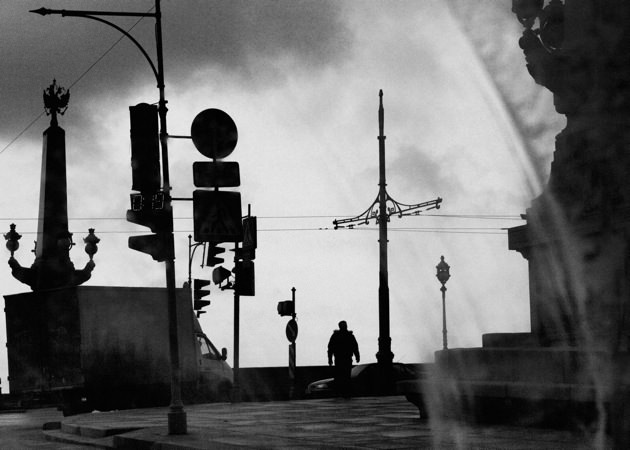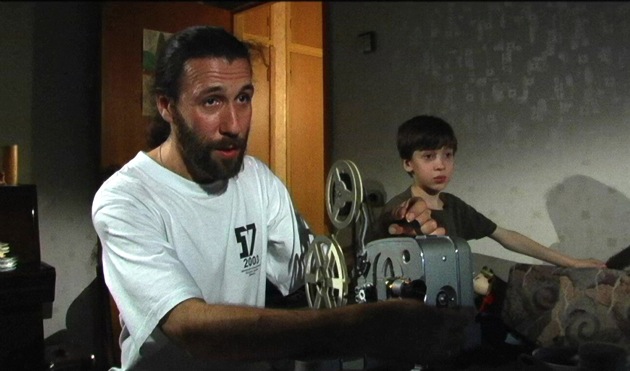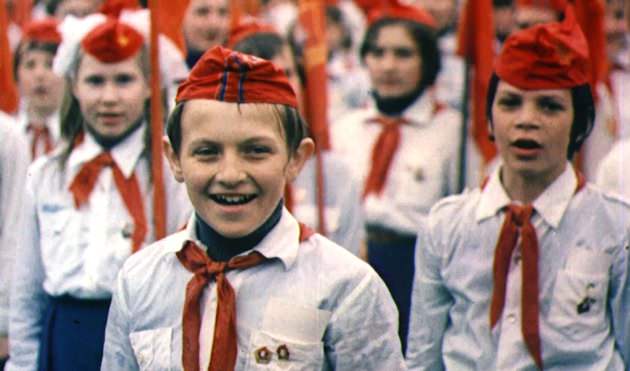You often hear the Putin era described as one of exhaustion and resignation on the part of the Russian electorate. Robin Hessman’s documentary My Perestroika, about the fall of the Soviet Empire as recalled by three men and two women now in their forties, fairly pulses with depressed resignation—pulses weakly, of course, resignation not being much of a stimulant. The film, which follows the five Muscovites as they go to work, feed their children, watch TV, and mull over their memories of the late eighties and early nineties, culminates on the day of a presidential election: it is May 2008 and Dmitri Medvedev, Putin’s handpicked successor, is about to be elected president. None of the interviewees is in suspense about who will win, none of them believes it is a fair election, none of them, as far as we can tell, votes for Medvedev, and at least two of them don’t vote at all.
This is a pretty sad turnout for a group that had once taken pleasure in voting and following politics. The five subjects were all schoolmates in the seventies and eighties. They were teenagers during Perestroika, and their adolescence coincided with that exquisite moment when it became clear that the Soviet regime was an impotent tyrant. None of them, as far as we know, came from families active in anti-Soviet dissent, but all of them supported Gorbachev’s reforms. Some joined the demonstrations protesting the 1991 attempted coup against Gorbachev by old guard communists. These protests led to the official dissolution of the Soviet Union.
The film’s affable central figures are Borya and Lyuba Meyerson, a couple who teach Russian history at an elite Moscow public school. They have been together romantically since they were teenagers, and they describe their transition from happy Soviet childhoods to adolescent disillusionment with the regime to heady open defiance: after glasnost they made a show of resigning their memberships in Komsomol—the Communist youth league, once mandatory for making one’s way in any career. But as Borya wryly notes, by the time they found the courage to quit, there were absolutely no consequences to doing so.
Borya and Lyuba have thought a lot about how to teach Soviet history—the USSR was a brutal and wrong-headed failed experiment, is roughly what they’ve settled on—and they are dismayed by Putin’s new guidelines for history teachers recommending a more positive approach to the Soviet past. One scene shows them watching Putin’s speech to history teachers on television: as Putin is saying that Russia “has much to be proud of,” we see them frowning at the television screen and then quietly lifting their hands to their faces in apparently unconscious gestures of dismay.
My Perestroika is about, among other things, money: the different ways of making and living with money that people new to capitalism have discovered. One of Hessman’s subjects, Andrei, operates a successful men’s clothing chain. He lives in a spacious, new-looking apartment, a striking contrast to the Soviet-era warrens that the other school friends live in. The ones who don’t make much money seem uneasily aware of wealth as something available—maybe not to them, not now, but to their generation. Olga, a single mother who works for a company that rents and services billiard tables, shares a tiny apartment with her son, sister, and nephew. “If you went to my friends’ houses, you’d see they live completely differently,” she says, “Their homes are beautiful and fancy.”
Ruslan, Borya’s closest friend, is a musician who panhandles in subway stations and gives private banjo lessons. In the 1990s he played in the punk band NAIV. He is proud never to have had a day job in either the Soviet or post-Soviet regimes. Ruslan insists that “nothing has really changed” since Soviet days—the only difference is that now you can buy all the “sausages, jeans, and chewing gum” that you want.
His scornful pronunciation of those three items is a nutshell critique of consumer capitalism. But what exactly does it mean to say that nothing has changed in Russia? The frustration of Hessman’s documentary is that she doesn’t follow up on these statements, allowing her subjects’ vague commonplaces to hang in the air as if they were climactic insights. “The ideals that burned in a person’s heart in the 1990s, they were profaned,” says Borya. “And there was nothing left to fight for.” Cut!
What were these ideals, Borya? What exactly did you hope for in 1991? What did you think would happen? How were your ideals profaned, and by whom? The film seems to take for granted that we know the answers to these questions, but in fact its very purpose depends precisely on making Borya spell it all out, as he sees it. Protestors who bring down a regime—not to mention young people in general—are fired by vague optimism and longing and many different, conflicting aspirations. Twenty years later, it’s time to be specific if we’re to understand anything at all about what happens after the fervent revolutionary moment is over.
Advertisement
The film instead provides its own interpretation of Borya’s words, cutting away at the word “profaned” to a Moscow street sign advertising Pepsi-Cola. A shot of a foreign currency exchange kiosk follows, and then another of a Russian sign for Pizza Hut. Mammon, in the form of international corporations and free markets, seems to be vaguely implicated in this montage. But is this actually what Borya is getting at? He never says anything to that effect in the film. Back in 1991, anti-coup protestors cheering on the fall of the Soviet empire were in favor of opening up markets and bringing an end to Soviet economic isolation—it could hardly have been worse than the bare grocery shelves they already had. Perhaps Hessman means the Western logos to point to the obvious ways in which Russian capitalism has fallen short of any conceivable ideal: it has brought income inequality, its spoils have become reserved for political cronies, it has undermined any sense of personal economic security.
But my own interpretation is that these street shots are less a critique of the Russian economic politics than something more sentimental: an expression of nostalgia for the old Soviet cityscape that was unprofaned by ads, billboards, flashing signs for Western goods, or any of the other visual clutter caused by big companies selling things for profit. This nostalgia might be called post-Soviet pastoral, if the definition of pastoral can be stretched to mean a longing for a landscape that was in fact industrialized and urban, but also, aesthetically speaking, a world of its own—insular, distinctive, and now vanished. Things in the Soviet Union looked different—cars, clothes, toys, household tools, the graphics and color schemes on packages and labels. Industrial and graphic designers worked in relative independence from the West. To an observer from the US, Soviet things seemed either to belong to an earlier era or to be entirely sui generis.
In the press materials for My Perestroika, Hessman writes that she first traveled to Russia as a college freshman in January of 1991. She mentions being struck by two things as she wandered the streets of Leningrad: the sense of hope and optimism she felt among the Russians she spoke to, and the still distinctively Soviet appearance of the city. I also traveled to Leningrad in early 1991. I was fifteen and it was my first time back in the country since my family had emigrated in 1980. I had no real memories from early childhood of what the city looked like, and when I arrived in 1991 I remember staring and staring at this strange parallel world that had the familiar architectural styles and street grids of a major European city but was denuded of most signage. Not only were there no billboards or bus ads, but (as Hessman also recalls) shops themselves did not have names. The sign above a fish market said Fish. Above a grocery, Produce. The literalism of the signs seemed pre-industrial. Or like a children’s train set village in which the miniature groceries and barber shops have the same generic appearance as the post offices and fire stations. The strangeness of the streetscape, combined with the exhilarating sense of political transformation, made the city magical to someone seeing it, effectively, for the first time in 1991.
To miss this landscape is of course not the same as wishing for a return to the Soviet Union, but one can still feel a stir at some of its more innocent trappings. Hessman’s subjects are straightforward about this: “Of course I get nostalgic. I was little, the sun was brighter, the grass was greener, the sky was bluer, and everything somehow seemed better,” says Borya of his memories of growing up in the 1970s. But the film seems to have a backhanded nostalgia of its own. A shot of Andrei watching TV in his large, gleaming living room makes his new house seem chilly and sterile compared to the tiny Soviet-era apartment where Borya and Lyuba are shown preparing dinner and teasing their son in affectionate close-ups.
Hessman also weaves in a great deal of old home movie footage of her subjects. In a documentary that has hard time getting its thoughtful, likeable subjects to say anything really interesting or surprising, the home movies are a crutch, or perhaps a canny diversion. As artifacts of a vanished world, they have a talismanic power to someone fascinated with Russia. If you’re something less than fascinated with Russia, you can still look at the adult subjects, look at the home movies, and contemplate again the baffling work of time. These people were children, the movie seems to repeat incredulously, forgetting for the moment about all its other concerns. Look at them then. Look at them now.
Advertisement
My Perestroika, directed by Robin Hessman, will be playing at theaters nationwide throughout the month of June.





